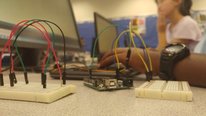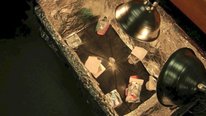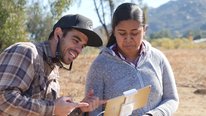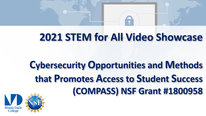- Jidong Huang
- Engineering Professor
- Presenter’s NSFRESOURCECENTERS
- California State University Fullerton, Anaheim Union High School District
- Amerika Bernal
- http://www.amerikabernal.com
- Business Mentor
- Presenter’s NSFRESOURCECENTERS
- California State University Fullerton
Science, Technology and Engineering Mini-business Incubator (STEM-Inc)
NSF Awards: 1433851
2017 (see original presentation & discussion)
Grades 6-8
STEM-Inc is a 3-year NSF ITEST project designed as an after-school program targeting 7th and 8th graders from Junior High schools, especially those from traditionally underrepresented groups. This project creates a mini technology business ‘incubator’ in an afterschool program for 7th and 8th grade students. It is a collaboration involving California State University Fullerton (CSUF)’s Colleges of Engineering and Computer Science (ECS), Business and Economics, and Education; and the Anaheim Union High School District (AUHSD). Its goal is to make junior-high students and their parents aware of STEM career paths in addition to engage and attract the students to STEM fields and careers. To this end, the project focuses on getting the students involved in exciting real-world projects that involve ECS, business concepts and Entrepreneurship practices. Junior-high school students participating in STEM-Inc work in groups to complete their project and each group is led by a student peer leader. In addition, all student participants are supervised and mentored by CSUF College Mentors and AUHSD teachers. As a design and development project, research questions frame formative data collection and analysis to address aspects of the design that are succeeding and others that require revision. Summative measures focus on what teachers and students learn, as well as attitudes toward science and engineering and self-efficacy.
Related Content for STEM-Inc
-
 2016STEM-Inc
2016STEM-Inc
Jidong Huang
-
 2021Collaboration Dynamics and Culturally Responsive Teaching
2021Collaboration Dynamics and Culturally Responsive Teaching
Meredith Kier
-
 2021Empowering Students in Math Through Entrepreneurship
2021Empowering Students in Math Through Entrepreneurship
Erin Krupa
-
 2018STEM-Starter: STEM Capstone for High School
2018STEM-Starter: STEM Capstone for High School
Elizabeth Radday
-
 2015Studio STEM
2015Studio STEM
Christine Schnittka
-
 2016Innovation Institute at the New York Hall of Science
2016Innovation Institute at the New York Hall of Science
Priya Mohabir
-
 2021Catalyzing Inclusive STEM Experiences: Tune in for Equity
2021Catalyzing Inclusive STEM Experiences: Tune in for Equity
Lara Hebert
-
 2015Exciting Engineering Minds
2015Exciting Engineering Minds
Nancy Taylor
Playlist: ATE Videos Playlist
-
 2021Guitars, Rocketry, Robotics
2021Guitars, Rocketry, Robotics
Chelsea Carnes
-
 2017STEM-Inc
2017STEM-Inc
Jidong Huang
-
 2021Using Bioinformatics to Introduce Students to Biotech Career
2021Using Bioinformatics to Introduce Students to Biotech Career
Sharon Gusky
-
 2021MATE Competition: Students Engineering Real-World Solutions
2021MATE Competition: Students Engineering Real-World Solutions
Jill Zande
-
 2021VR: Sustaining Social Interaction STEM Engagement and Access
2021VR: Sustaining Social Interaction STEM Engagement and Access
Jonathan Beck
-
 2021Rapid Response Additive Manufacturing Initiative (RRAMI)
2021Rapid Response Additive Manufacturing Initiative (RRAMI)
Eric Wooldridge
-
 2020Preparing Technicians for the Future of Work
2020Preparing Technicians for the Future of Work
Ann-Claire Anderson
-
 2020Guitars, Rocketry, and Robotics ATE
2020Guitars, Rocketry, and Robotics ATE
Chelsea Carnes
-
 2020From Classrooms and Camps to College and Technical Careers
2020From Classrooms and Camps to College and Technical Careers
Sharon Gusky
-
 2020Promoting Interest in Drone Applications and Careers
2020Promoting Interest in Drone Applications and Careers
Wing Cheung
-
 2020Incorporating Geospatial Technologies into the Classroom.
2020Incorporating Geospatial Technologies into the Classroom.
Devon Russell
-
 2020Scaling Up the Automated Manufacturing Technician Pipeline
2020Scaling Up the Automated Manufacturing Technician Pipeline
Mason Lefler
-
 2020The Future Workforce Begins with a Spark
2020The Future Workforce Begins with a Spark
Jonathan Beck
-
 2020Controls Tech Barbie and her Smart Barbie Grand Hotel
2020Controls Tech Barbie and her Smart Barbie Grand Hotel
Deb Hall
-
 2021Increasing Opportunities for Underrepresented Minorities
2021Increasing Opportunities for Underrepresented Minorities
Diego Tibaquira
-
 2020Merry Mobile Robot Platform
2020Merry Mobile Robot Platform
Mahmood Lahroodi
-
 2020AMP-IT-UP: Inspiring middle school teachers in STEM
2020AMP-IT-UP: Inspiring middle school teachers in STEM
Meltem Alemdar


Pati Ruiz
Dean of Studies, CSHNYC
Your project sounds like a great opportunity for students in your community! It is so important to expose students to STEM opportunities and to career opportunities in the field. The field trip opportunity seems like a great learning experience, too! How do you recruit your students? Are the students grouped based on gender? I noticed the groups in the video seemed to lean towards single-genders, but that might just have been the footage you were able to capture. Also, how are you making sure that students from diverse backgrounds persist and feel supported in the project? Do your mentors come and supervisors come from diverse backgrounds as well? Finally, are the family members of these students involved in any way?
Jidong Huang
Engineering Professor
Thanks a lot for the positive comments. We recruit students through several ways, for instance, teacher’s announcements in Math & Science classes, STEM-Inc open house in Sept, peer references, and telephone notice to parents.
No, the groups were not formed by gender. They were formed by similar interests to work on the same design project at the end of school year. At the beginning, students are required to propose different project ideas with business potentials to work on. Groups were then formed to work on same topic of interests. We do have co-ed teams in the project; and also observed that there were multiple single-gender groups as students like to work with friends, too.
We use multiple ways to ensure retention of the students, for example, using college mentors from similar background (Hispanic, Female, etc.); giving incentives for participation (snacks, awards); having competitions with awards to keep it fun; having field trips and inviting industry speakers to inspire the students; and also multiple formative surveys to collect the students’ opinion on the program.
Yes, we try our best to have CSUF college mentors and STEM-Inc teachers from similar background of students.
Family members of students are involved mainly in several events: parent orientation at the beginning of the year; parent workshops on engineering and computer science; parent information booth on engineering and computer science; annual showcase & awards at the school district demonstrating student projects.
Bill Swift
Dear Dr. Huang:
Thank you for putting so much time and effort into your program to get youth hooked on STEM in the Anaheim area. STEM Inc. looks like a great program. Having all those opportunities to get hands on experience with STEM whether building a robot or an app is great, but more than that, having business and science mentors and leadership workshops also exposes youth to innovative new ideas and the foundations of how do you start a business, how do you think like an entrepreneur. I really liked the interview with a student, where she says: "it showed me there was a whole world waiting out there for me to make something new." You need help to get to those realizations. Thank you for being there for your students.
Bill Swift
Jidong Huang
Engineering Professor
Hi, Bill,
Thanks a lot for the nice comments. Yes, we do think 7th and 8th grade is the right time to exposure students to various STEM subjects; and they have the ability to learn some very skilled topics, like robotics, 3D printing and mobile app development. Having students work on age-appropriate STEM projects in after-school definitely engages them and provides them new opportunities they may not have thought about or have no or little access to, especially to those traditionally underrepresented students.
The idea of connecting STEM education with Entrepreneurship training is the key to success in our project. It gives students opportunity to develop soft skills and explore the unlimited potentials within themselves, for instance, the ability of brainstorming and idea generation, engagement in public speech, effective communication through fast pitch, writing design documents and creating business plans, managing time and resources for the project, and critical thinking through group discussions. We are also happy students are enjoying this program. We even got multiple inquiries from parents how we can expand the project into high schools so that their children can continue after this.
Best,
Jidong
Barbara Ericson
What is your retention rate (how many students stay in the program)? Is it offered at their usual schools? Is there a fee?
Jidong Huang
Engineering Professor
Thank you for the questions. The retention rate varies at different schools, between 70% to 95%. The dropout mainly happens during semester switch from Fall to Spring because of students’ schedule changes resulted by competitions from other after-school activities like sports and arts. But, during the semester (either in Fall or Spring), students mostly stay through. Yes, this project is offered at 4 junior high schools; and students were recruited from those schools. The project is sponsored by an NSF ITEST grant, so there is no fee for participation as we are conducting research and pilot studies using the NSF funds.
Rowena Douglas
Program Officer; Asst. Executive Director; Director for PD
The coordination of after school programs managed or funded by organizations in collaboration with the school district are so important yet is a challenge. How are the AUHSD teachers supported by the district? Are they selected by the university? I am truly interested in your design and in your research questions. I imagine that the program is also a professional development opportunity for the university staff in working with teachers, as well as with middle-level students.
Jidong Huang
Engineering Professor
Thanks a lot for the comments. Luckily, we were able to get a good school district to work with. The Anaheim school district is very collaborative. We have one grant coordinator at the school district who is also their science curriculum specialist. She helps us reach out to teachers and school principles to make sure project activities are carried out as planned.
School principles are on board from the beginning of the project, and provide great support with recruitment of STEM-Inc teachers and students, reaching out to parents, providing use of classroom, equipments and facilities.
The teacher’s participation is funded by the NSF grant. They were selected by the school principles; and receive professional development from us from time to time. Our research is to look into how an integrated engineering and computer science experience (for instance, STEM content learning; connecting STEM with Business practices; use of college mentors; involving parents and industry representatives in the project; introducing specially trained student peer leaders) can engage students, especially those underrepresented ones in STEM learning.
Yes, this project is a very good learning experience for everyone involved. We learned how to work with schools and school district to train teachers and educate students out of classroom. Mentors developed teaching skills. Teachers learned how to incorporate ideas from this project into their classroom teaching. Students, of course, learned about both Engineering, Computer Science and Entrepreneurship practices.
Rowena Douglas
Program Officer; Asst. Executive Director; Director for PD
You have great support from the district. That is wonderful. How much time do you spend with the principals? Are you doing a pre-post test on the students' STEM knowledge?
Jidong Huang
Engineering Professor
The school principals are on the advisory board for the project. When we started in the first year, the project staff and school principals met every month for planning of project activities. For years 2 and 3, since the program structure is pretty established, we only met with the principals about twice in a semester for coordination of certain events, for instance, annual advisory board meetings; parent open houses; parent workshops; annual showcase, etc. The project has a shared directory containing contact information for PIs, college mentors, AUHSD grant coordinator, teachers, and school principals. So, we were able to communicate whenever needed.
Yes, we do pre/post test students on knowledge in both STEM and Business subjects. We also pre/post test students’ interests and self-efficacy towards STEM and Business. The actual Engineering/Business learning outcomes were measured by a set of surveys at the end of year, including student self-surveys, teacher/mentor surveys, and advisory board member surveys.
Lisa Samford
Executive Director
It is particularly interesting to me that you've combined fab, fun and inspiring STEM activities with leadership, communication and entrepreneurial skills. Are you doing any follow up or assessment of students and mentors after they complete their project year? Is there an option for them to continue on? If so, how many do so.
Jidong Huang
Engineering Professor
Thank you for the precise observation. We do try our best to present to students a unique experience of STEM-learning in afterschool.
Unfortunately, at this time, we do not have follow-up assessment data. We actually developed a STEM-Inc alumni survey; but the project is only three-year long; and we had been busy making adjustments and improvements to implement and refine the program. We actually submitted proposals to try continuing this effort with more research to do at the school district; and the follow-up assessment was one item we want to explore should we have future opportunities to work with the school district. But the proposals didn’t go through.
We did see some 7th grade students coming back when they are in 8th grade to serve as peer leaders; and some graduates, now in 9th grade, coming back to the schools to serve as volunteers for the project.
Erika Scheffler
I think this is a great program for students to attend twice a week for a few hours to peak their interest in STEM. I found the focus on engineering and computer science to be really beneficial for those students interested in a career path in STEM or those who want to know more about it. I was really interested in the robotics, 3D printing and mobile app development the program has to offer. All these activities provide the opportunity for authentic learning to happen among students. I think having students solve problems and collaborate ideas with one another is an essential and necessary to skill to have in today’s world. I especially thought providing an opportunity to learn about entrepreneurship was a good idea with the intended age group of 7th and 8th graders.
Jidong Huang
Engineering Professor
Thanks a lot for the nice comments. Yes, we do try our best to pick up topics where students would have great interests to work on; and we try to use the Business practices to help students understand the potential values in STEM studies; and empower them with tools needed for such explorations. Many times, once you get the students started, they will continue on their own. Of course, there could be challenges on the way, but if there is appropriate guidance and mentoring around, students will feel motivated and supported.
Donna Charlevoix
Great project and making an impact! What are your plans for sustainability after the grant ends?
Jidong Huang
Engineering Professor
Thanks! The grant is ending soon. As I mentioned earlier, we tried sending in new proposals to continue such efforts with new research focus at the school district but was not able to get it this round. We will resubmit; and hopefully will be able to get it in the future.
Talking about the sustainability of the project, we have trained several teachers for each school, who are now very familiar about the STEM-Inc program contents. The equipment and project supplies we bought, such as 3D printers, robotic kits, tablet computers, and electronics will stay in the schools. The teachers can use these supplies to continue either in their class or in a similar afterschool program, providing some support can be made from the school or the district. As a matter of fact, one teacher has volunteered to pilot this to incorporate our instructional modules in his computer class this year. So, his students are now working on 3d printing, robotics, and app development, instead of doing the regular word and spreadsheet processing. It appears well accepted by his students in class already.
Lisa Samford
Executive Director
It's great that the project will continue to impact students beyond the grant period! It's so important to engage middle school aged students in STEM--it is such a critical age as students begin to engage personally with the world around them.
Jidong Huang
Engineering Professor
Yes, we are trying to sustain the project as much as we can. After all, after working hard on the project for three years, everyone becomes part of it; and feels the need to continue beyond this. We also agree that middle school is the right time to expose students to fun STEM activities as they start to think what they want to become when they grow up.
Kristin Hellman
This program seems to be intriguing a lot of students. It's amazing how it is providing them with so many opportunities to be hands on and learn about the field of engineering. During the video, a small snippet showed students on field trips. What kind of places did they go to? Have they had the chance to go to places to present their ideas and findings? I would love to hear more about this program and what all students have done with it so far
Jidong Huang
Engineering Professor
We had field trips to several places: Discovery Cube, a very well-known science center serving orange county and around; several engineering companies close to campus; and lab tours to the engineering college at our campus. Students did participate in the annual fast-pitch competition held by CSUF where professionals and entrepreneurs judge on the quality of business ideas from both college and high school students in the region. Based on surveys collected from students, they were very satisfied with most of our project activities. Please feel free to ask what else you want to know about our program, too.
John B. Jackson
The middle schools students were fearless and embraced STEM despite the newness of the information. Congrats to you Jidong.
Further posting is closed as the event has ended.